“There are twenty million women in this island, and I’ve got to be chained to you.”—— Robert Donat to Madeleine Carroll
In a typical Hitchcockian quirk, or clear evidence of his individuality, the title was to be numeric—The 39 Steps—not letters, as in John Buchan’s 1915 novel, The Thirty-Nine Steps. Small point, perhaps, for from the book the director removed and added whatever he liked for his movie. The most original adjunct, and a major one, is the romance necessary in any Hitchcock film. Also added are the music hall finale and the scene with the tenant farmer, a seemingly irrelevant but poignant episode a third into the film.
When author Buchan, also an historian and politician, who died in 1970, saw the film, he admitted to Hitchcock that his decidedly uncinematic novel had been turned into something far better.
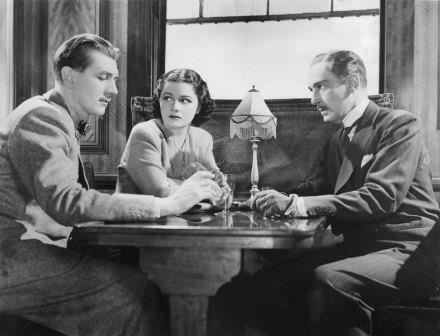 With the possible exception, for some, of The Lady Vanishes (1938), The 39 Steps is the finest of Hitchcock’s English films. It was the first of six before he departed for Hollywood and the inaugural splendor of Rebecca (1940), and fame even greater than he had experienced in England. The last film there, Jamaica Inn (1939), a costume drama that showed the director awkwardly out of his depth, was as good a sign as any that he was ready to leave, and the next similar film he attempted, Under Capricorn (1949), proved that he had yet to master the genre.
With the possible exception, for some, of The Lady Vanishes (1938), The 39 Steps is the finest of Hitchcock’s English films. It was the first of six before he departed for Hollywood and the inaugural splendor of Rebecca (1940), and fame even greater than he had experienced in England. The last film there, Jamaica Inn (1939), a costume drama that showed the director awkwardly out of his depth, was as good a sign as any that he was ready to leave, and the next similar film he attempted, Under Capricorn (1949), proved that he had yet to master the genre.
In these English films, both The 39 Steps and Young and Innocent (1937) would validate one of Hitch’s favorite themes, that of the innocent man on the run, wrongfully accused of a crime and eager to stop some criminals or find one of the director’s famous MacGuffins, an object or a plan. As in these two films, The Lady Vanishes also contains another Hitchian motif, a cross-country journey, only the “man” in this case is a young lady, Iris Henderson (Margaret Lockwood).
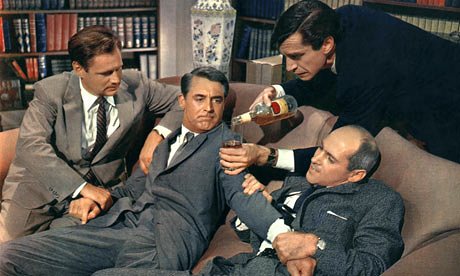 The journey theme in The 39 Steps continues in a number of his subsequent American films—the best examples being Saboteur (1942), in which Robert Cummings flees arrest across the U.S. in search of the guilty parties (Otto Kruger and Norman Lloyd), and that definitive example,North by Northwest (1959), in which Cary Grant must prove he isn’t a George Kaplan and prevent the spies from leaving the U.S. with some microfilm. Some non-journey films contain within them short journeys—most tragically Janet Leigh’s in Psycho (1960), absconding with $40,000 and tragically stopping, twenty minutes into the movie, at the Bates Motel; and, in Marnie (1964), Tippi Hedren and Sean Connery’s visit to her mother’s for the climactic revelation.
The journey theme in The 39 Steps continues in a number of his subsequent American films—the best examples being Saboteur (1942), in which Robert Cummings flees arrest across the U.S. in search of the guilty parties (Otto Kruger and Norman Lloyd), and that definitive example,North by Northwest (1959), in which Cary Grant must prove he isn’t a George Kaplan and prevent the spies from leaving the U.S. with some microfilm. Some non-journey films contain within them short journeys—most tragically Janet Leigh’s in Psycho (1960), absconding with $40,000 and tragically stopping, twenty minutes into the movie, at the Bates Motel; and, in Marnie (1964), Tippi Hedren and Sean Connery’s visit to her mother’s for the climactic revelation.
As it opens and ends in a music hall, The 39 Steps is also another of Hitchcock’s “theatrical” films, where the plot includes the stage/theater, the movies, classical concerts—actors’ role-playing in Stage Fright (1950), the showing of Disney’s cartoon “Who Killed Cock Robin” in Sabotage (1936), the concert in the two versions of The Man Who Knew Too Much (1934, 1956) and the ballet performance in Torn Curtain (1966).
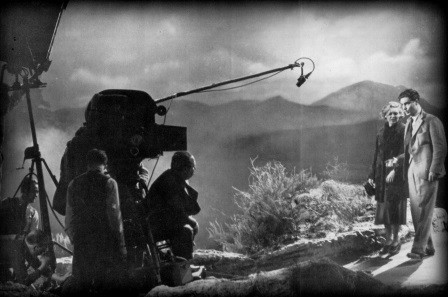 The best music in The 39 Steps, to a large extent by default due to Louis Levy’s weak score, occurs as popular source music. The opening and closing of the film in theaters feature two popular tunes by Harry M. Woods, “Dancing with My Shadow” and “Tinkle, Tinkle, Tinkle.” During one of Robert Donat’s many escapes, a Salvation Army band appears briefly playing “In the Sweet By and By” and “We Shall Win.”
The best music in The 39 Steps, to a large extent by default due to Louis Levy’s weak score, occurs as popular source music. The opening and closing of the film in theaters feature two popular tunes by Harry M. Woods, “Dancing with My Shadow” and “Tinkle, Tinkle, Tinkle.” During one of Robert Donat’s many escapes, a Salvation Army band appears briefly playing “In the Sweet By and By” and “We Shall Win.”
The last tune was arranged by British veteran film composer Charles Williams, who, more famously, wrote the rhapsodic music for the 1947 film While I Live, better known in its 1950 reissue as The Dream of Olwen. Generally now forgotten, Herbert Bath, also British, arranged theRussian Dance, composer unknown, in The 39 Steps. Bath composed the Cornish Rhapsody for the Albert Hall sequence in Love Story (1944)—not the 1970 film of that title—and known in the U.S. as A Lady Surrenders.
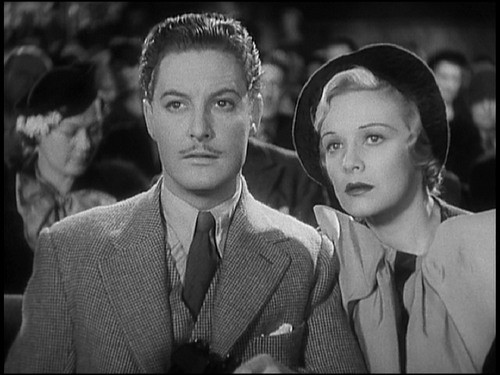 It is, above all, source music, the tune from the music hall which Donat’s character can’t get out of his head and forgets where he had heard it, that forms the leitmotif of the film—if there is one, more important than the five-note phrase introduced in Levy’s main title. When Donat does deduce the tune’s importance, it leads to the solution of the mystery, much as the folk song is the impetus in The Lady Vanishes.
It is, above all, source music, the tune from the music hall which Donat’s character can’t get out of his head and forgets where he had heard it, that forms the leitmotif of the film—if there is one, more important than the five-note phrase introduced in Levy’s main title. When Donat does deduce the tune’s importance, it leads to the solution of the mystery, much as the folk song is the impetus in The Lady Vanishes.
The 39 Steps is meant to be, and is, fun. The lines exchanged between Donat and Madeleine Carroll, even in the beginning when they are negative and mocking, are priceless. This is the work, not of Buchan of course, but of a screenwriting team of Hitch, Charles Bennett and the director’s wife, Alma.
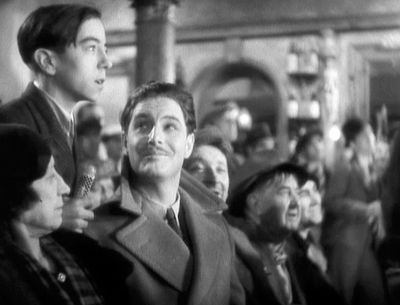 Richard Hannay (Donat) is at a London music hall, enjoying the prodigious mental recall of a “Mr. Memory” (Wylie Watson), and even asking a question, the distance from Winnipeg to Montreal, and receiving a correct answer. “Am I right, sir?” the little man asks. But then gun shots are heard.
Richard Hannay (Donat) is at a London music hall, enjoying the prodigious mental recall of a “Mr. Memory” (Wylie Watson), and even asking a question, the distance from Winnipeg to Montreal, and receiving a correct answer. “Am I right, sir?” the little man asks. But then gun shots are heard.
Outside, as the crowd flees the theater, Hannay is shuffled against a woman (Lucie Mannheim) who asks, “May I come home with you?” At his flat, she asks him to turn a mirror to the wall, close the curtains and not to answer the telephone, which suddenly begins ringing. “It’s for me,” she remarks. She says he may call her Annabella Smith, adding that her name “depends on where I am.”
She explains that she is a spy, a British one only because “the British pay better,” and that she fired the shots in the music hall as a diversion. Two men are after her. She says there is an organization, The Thirty-Nine Steps, that is plotting to take military information out of the country. The leader, with “a dozen names,” has part of his little finger missing.
 Later that night the woman staggers into Hannay’s bedroom, stabbed fatally in the back, warning him to flee. Clutched in her hand is a map of the Scottish Highlands, with the village (fictional) of “Alt-na-Shellach” circled. The two men Hannay had seen from the window are still outside, so he borrows the coat and cap of the milkman (Frederick Piper) and escapes—only the first of many to come.
Later that night the woman staggers into Hannay’s bedroom, stabbed fatally in the back, warning him to flee. Clutched in her hand is a map of the Scottish Highlands, with the village (fictional) of “Alt-na-Shellach” circled. The two men Hannay had seen from the window are still outside, so he borrows the coat and cap of the milkman (Frederick Piper) and escapes—only the first of many to come.
When boarding a train, the famous Flying Scotsman, Hannay briefly shares a compartment with two ladies’ underwear salesmen (Gus McNaughton and Jerry Verno), who discuss their competitors and hold up a girdle—certainly then a titillating subject, added by Hitch. From the men’s newspaper, Hannay learns that he is wanted for Smith’s murder.
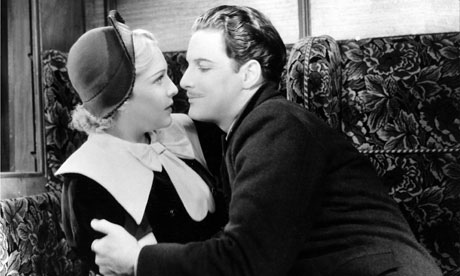 Trying to elude the police, he barges into a compartment and kisses a young lady, Pamela (Carroll), as a dodge. She exposes him, he runs through the train, the police pull the emergency brake and, with the train stopped on the Forth Bridge, Hannay is able to escape.
Trying to elude the police, he barges into a compartment and kisses a young lady, Pamela (Carroll), as a dodge. She exposes him, he runs through the train, the police pull the emergency brake and, with the train stopped on the Forth Bridge, Hannay is able to escape.
In a seemed respite, next Hannay spends the night at a crofter’s cottage. The husband (John Laurie), a religious fanatic, is suspicious of his sheltered wife (Peggy Ashcroft), who wants to hear from Hannay about the outside world. When she warns him of an approaching police car, she gives him her husband’s coat and Hannay flees once again——
 To Alt-na-Shellach, and he arrives, amazingly, at the right house, telling Professor Jordan (Godfrey Tearle) that he’s been sent by Smith. After Hannay has mentioned his plight and The Thirty-Nine Steps, Jordan shows him his right hand, its little finger missing, and shoots him.
To Alt-na-Shellach, and he arrives, amazingly, at the right house, telling Professor Jordan (Godfrey Tearle) that he’s been sent by Smith. After Hannay has mentioned his plight and The Thirty-Nine Steps, Jordan shows him his right hand, its little finger missing, and shoots him.
Luckily, inside the crofter’s coat Hannay had been given a hymn book absorbs the bullet. He soon regains consciousness. He then goes to the sheriff (Frank Cellier), who doesn’t believe that friend and upstanding citizen Jordan is a spy, but before the second handcuff can be fastened, Hannay escapes through a window.
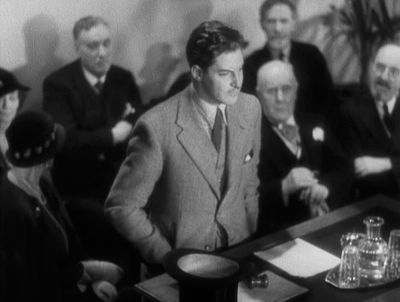 He joins a group of marchers accompanied by a Salvation Army Band, a trick used by Harrison Ford who joins a St. Patrick’s Day parade in The Fugitive (1993), itself a reprise of Hitch’s theme of an innocent man on the run. Hannay seeks refuge in the crowd at a political meeting, and, mistaken for one of the speakers, renders a hilarious impromptu address, hiding the one handcuffed hand in his pocket.
He joins a group of marchers accompanied by a Salvation Army Band, a trick used by Harrison Ford who joins a St. Patrick’s Day parade in The Fugitive (1993), itself a reprise of Hitch’s theme of an innocent man on the run. Hannay seeks refuge in the crowd at a political meeting, and, mistaken for one of the speakers, renders a hilarious impromptu address, hiding the one handcuffed hand in his pocket.
Pamela, who just happens to be present, alerts the police. They apprehend Hannay and request she accompany them, but, strangely, the car drives past the police station, then takes a wrong road. Hannay realizes these are not policemen but members of The Thirty-Nine Steps. When a flock of sheep blocks the road, and before the “police” alight to disperse the animals, one of the men clamps Hannay’s loose handcuff to Pamela’s wrist. “As long as you stay,” he tells her, “he stays.”
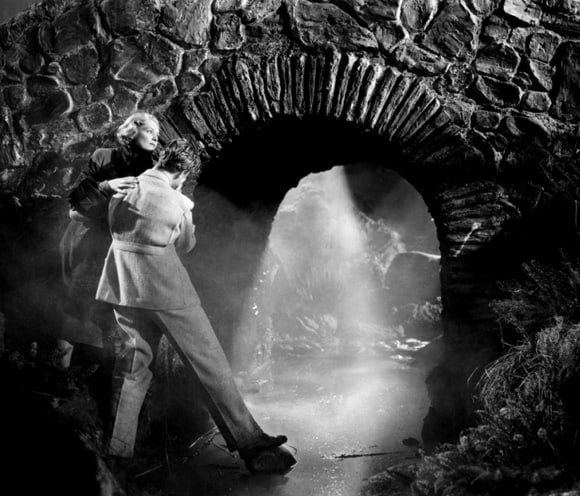 The opportunity provided, the couple escape, hiding from their pursuers behind a waterfall. Carroll is thoroughly drenched, which, it was reported, pleased the sadistic Hitchcock to no end, he who had handcuffed his two stars together before filming had even begun and then disappeared in search of the “lost” key.
The opportunity provided, the couple escape, hiding from their pursuers behind a waterfall. Carroll is thoroughly drenched, which, it was reported, pleased the sadistic Hitchcock to no end, he who had handcuffed his two stars together before filming had even begun and then disappeared in search of the “lost” key.
The couple arrive at an inn and pose as newlyweds. “Do every single thing I tell you to do,” he had told her earlier, “and do it quickly.” He suggests she sign the register, to become used to “her new name,” and dictates, “Mr. and Mrs. Henry Hopkinson, The Hollyhock, Hammersmith.”
The banter between them in their room is priceless. Hannay suggests Pamela remove her skirt: “It’s still pretty damp. I don’t want to be tied to a pneumonia case on top of everything else.” “I’ll keep it on, thank you,” she replies. In the entire film, the best moment of well-written repartee and caustic humor occurs when they are lying on the bed together. She asks him how he began his life of crime.
“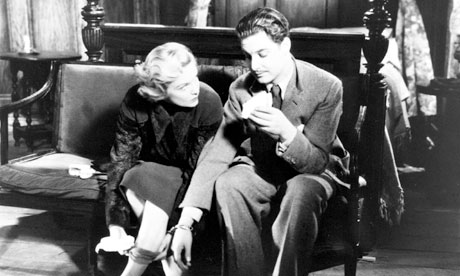 In quite a small way,” he replies, “like most of us—pilfering pennies from other children’s lockers at school, then a little pocket-picking, then a spot of car pinching . . . Killed my first man [yawning] . . . when I was nineteen. In years to come, you’ll be able to take your grandchildren to Madame Tussaud’s and point me out. . . . ” He says it’s too early to say in which section his wax image will be found. “I’m still young. But I’ll be there all right, in one department or another. You’ll point me out and say, ‘Chicks, if I were to tell you how matey I once was with that gentleman . . . ’ ”
In quite a small way,” he replies, “like most of us—pilfering pennies from other children’s lockers at school, then a little pocket-picking, then a spot of car pinching . . . Killed my first man [yawning] . . . when I was nineteen. In years to come, you’ll be able to take your grandchildren to Madame Tussaud’s and point me out. . . . ” He says it’s too early to say in which section his wax image will be found. “I’m still young. But I’ll be there all right, in one department or another. You’ll point me out and say, ‘Chicks, if I were to tell you how matey I once was with that gentleman . . . ’ ”
Later, while her companion sleeps, Pamela slips her hand out of the handcuff and overhears one of the bogus policemen on the telephone, confirming that Hannay has been telling the truth. The next morning she tells him what she had overheard, that The Thirty-Nine Steps are “clearing out” and picking up their “friend” at the London Palladium.
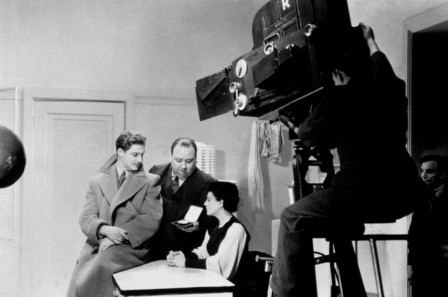 Hannay proceeds to the Palladium and sends Pamela to tell Scotland Yard, who don’t believe her spy story, but do follow her to the theater. Pamela finds Hannay seated in the audience. The orchestra plays the tune he has been unable to get out of his head and realizes it’s from the music hall, and when “Mr. Memory” is introduced, Hannay deduces that the secret military information is stored in the man’s memory.
Hannay proceeds to the Palladium and sends Pamela to tell Scotland Yard, who don’t believe her spy story, but do follow her to the theater. Pamela finds Hannay seated in the audience. The orchestra plays the tune he has been unable to get out of his head and realizes it’s from the music hall, and when “Mr. Memory” is introduced, Hannay deduces that the secret military information is stored in the man’s memory.
The police try to arrest him. Hannay cries out to “Mr. Memory,” “What are The Thirty-Nine steps?” And the man, trained to answer questions, is compelled to reply: “The Thirty-Nine Steps is an organization of spies, collecting information on behalf of the Foreign Office of——” From a balcony, Jordan shoots him, runs across the stage, but is caught.
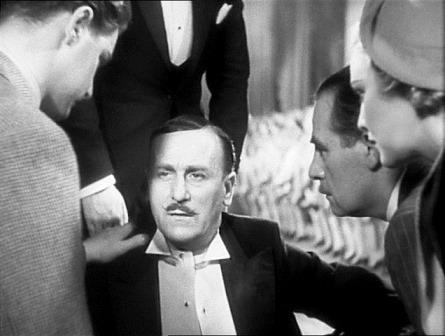 Before “Mr. Memory” dies, he recites the formula for an aircraft engine. Behind him, a chorus of girls high-step to “Tinkle, Tinkle, Tinkle.” In the final shot, Hannay reaches over, the one vacant handcuff still dangling, and clasps Pamela’s hand.
Before “Mr. Memory” dies, he recites the formula for an aircraft engine. Behind him, a chorus of girls high-step to “Tinkle, Tinkle, Tinkle.” In the final shot, Hannay reaches over, the one vacant handcuff still dangling, and clasps Pamela’s hand.
Alfred Hitchcock was sometimes dissatisfied with the stars he had to accept, either because of studio pressure to use contract players or the need to promote the latest screen sensations. Such could not be said of the perfect casting in The 39 Steps, for Hitch acquired the actors he wanted.
Some have written that Robert Donat is a cross between Clark Gable—because of the mustache?—and Ronald Colman—because of the precise British diction? Strange comparisons perhaps. Less aggressive than Gable and yet more physical than Colman, Donat is alternately debonair, clever, acerbic and romantic, as required, toward his handcuffed traveling companion. He is the star of the show and carries the responsibility with confidence, if with a bit of arrogant charm.
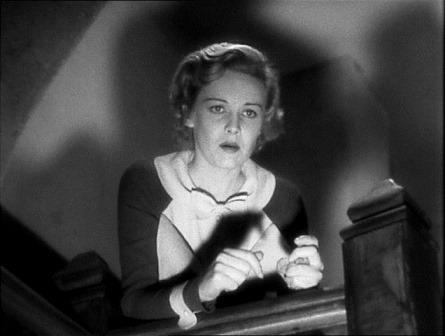 But he is ably assisted, perhaps essentially, by Madeleine Carroll, because the two are a team. She would star the next year in the director’s Secret Agent. The first of Hitch’s famous blondes, she stands in good stead alongside her blonde successors—Ingrid Bergman, Grace Kelly, Janet Leigh, Kim Novak and, maybe (?), Tippi Hedren.
But he is ably assisted, perhaps essentially, by Madeleine Carroll, because the two are a team. She would star the next year in the director’s Secret Agent. The first of Hitch’s famous blondes, she stands in good stead alongside her blonde successors—Ingrid Bergman, Grace Kelly, Janet Leigh, Kim Novak and, maybe (?), Tippi Hedren.
The role of Pamela rarely requires Carroll to be demure, coquettish or seductive—there’s hardly the time in this fast-paced film—but she makes a good traveling companion, just by her attractive presence. She is the perfect foil for Donat, be it playfully negative much of the time. He drags her along as if she were a part of him. The closest the two come to co-operation—dare it be called romantic?—occurs when they are on the bed at the inn, still handcuffed: they share a meal and attempt to free themselves with her fingernail file.
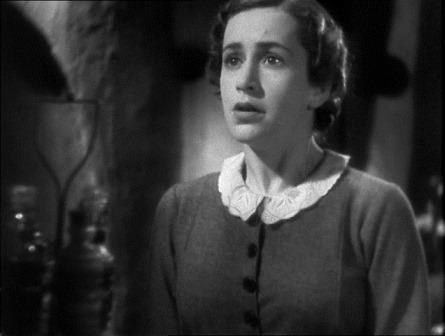 Peggy Ashcroft, admired by Hitch for sometime, renders a soft, sympathetic, even movingly sad performance as a neglected wife. As Ashcroft’s husband, John Laurie, who starred in six of Laurence Olivier’s movies, is sullen and self-motivated, his religious façade easily cracked with a financial bribe. John Tearle is another of Hitchcock’s suave villains, convincingly played, although here his brief appearances allow for little development.
Peggy Ashcroft, admired by Hitch for sometime, renders a soft, sympathetic, even movingly sad performance as a neglected wife. As Ashcroft’s husband, John Laurie, who starred in six of Laurence Olivier’s movies, is sullen and self-motivated, his religious façade easily cracked with a financial bribe. John Tearle is another of Hitchcock’s suave villains, convincingly played, although here his brief appearances allow for little development.
No more than Hitchcock bothered to explain—nor did he know himself—what was on the microfilm in North by Northwest, the loose ends in The 39 Steps are numerous. Why, for example, did Anabella Smith stay in Hannay’s flat, even go to bed, when she knew those two men were still outside? What coincidence placed Pamela, so conveniently, at the political meeting, other than to accompany Hannay across Scotland? How was Hannay able, first time, to find the villain’s house? As stated earlier, The 39 Steps is meant to be, and is, fun. The loose ends don’t matter. The film is only to be enjoyed.
